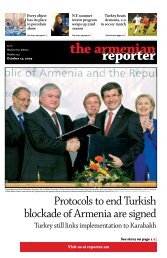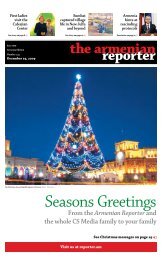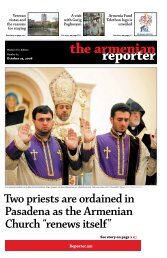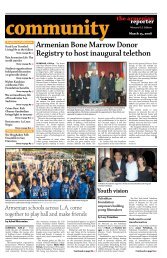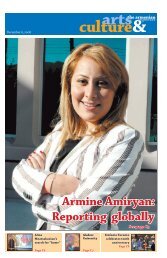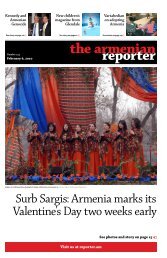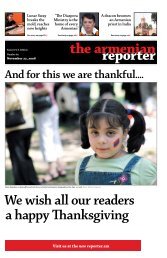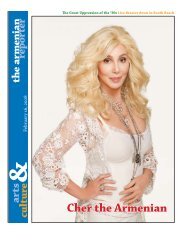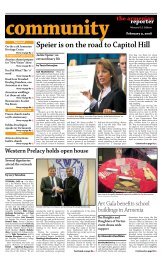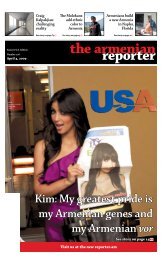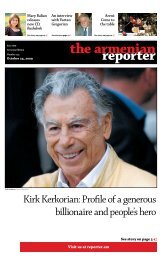National, International, Armenia, and Community News and Opinion
National, International, Armenia, and Community News and Opinion
National, International, Armenia, and Community News and Opinion
- No tags were found...
Create successful ePaper yourself
Turn your PDF publications into a flip-book with our unique Google optimized e-Paper software.
6 The <strong>Armenia</strong>n Reporter | May 2, 2009<strong>Community</strong>MY NAME ISARMENThe last columnby ArmenBaconThere’s a saying that all good thingsmust end. I’m not sure if I’m completelysold on the idea, or if I evenbelieve it to be true, but since thisweek marks my final column forthe <strong>Armenia</strong>n Reporter, I’ll have toagree, just this once. There is simplynothing finer than connectingwith others, especially when thethread of culture, heritage, <strong>and</strong>family create a brilliant <strong>and</strong> colorfulbackdrop for our shared stories<strong>and</strong> life experiences. To that end,I’ve had the time of my life writingthis column.When I began writing for thepaper a few years ago, I worriedincessantly that I might fall shorton words, memories, or the abilityto be a good storyteller. Afterall, it is a bit daunting to have aweekly deadline that requires 1,000well-written words sent from Californiato <strong>Armenia</strong> <strong>and</strong> then distributedaround the globe. It certainlybrought me face to face with myinner demons <strong>and</strong> self-imposed insecurities.Those deadlines wouldstare me straight in the eye, <strong>and</strong>then plead with me to come upwith an interesting topic that mightmake for a good read. Some weeksthe stories wrote themselves; othertimes I had to hunt them down.It has been a joy to sit down atmy computer each week to meetthese deadlines. My greatest pleasurehas been the opportunity toget reacquainted with a cast of fascinatingfriends <strong>and</strong> relatives I haveknown during this lifetime. Theyare responsible for my best <strong>and</strong> favoritestories. From my own motherto Auntie Rose <strong>and</strong> Uncle Milton,I have resurrected memories of thepeople I love who have made (<strong>and</strong>continue to make) an indelible imprinton my life. “My Name is Armen”has allowed me to lift themonto the page <strong>and</strong> celebrate theirprofound impact. Without the column,many of their stories wouldstill be under cover or in hiding.As a result of the column, I havecoaxed them out, set them free<strong>and</strong> enjoyed reliving their magical,memorable moments.I have received e-mails frommany of you. You are vigilant in remindingme that we have much incommon. It is satisfying to knowthat at the end of the day, we areall brothers <strong>and</strong> sisters. You havethanked me for writing about thehuman spirit as well as our resilience<strong>and</strong> unwavering passion forlife <strong>and</strong> love. We are all dismayed atthe dem<strong>and</strong>ing pace of this modernSince 2004, Armen D. Bacon’s thoughts<strong>and</strong> reflections about life have beenpublished in the “Valley Voices” sectionof the Fresno Bee as well as the <strong>Armenia</strong>nReporter. She also writes, produces, <strong>and</strong>hosts a radio series titled “Live, Laugh,Love” on Fresno’s K-jewel 99.3 radio.She can be reached at armendbacon@aol.com.day lifestyle <strong>and</strong> how it sometimesrobs us of our humanity. We are eager<strong>and</strong> desperate to make eye contactwith each another. You havethanked me for small moments inmy column when you have read mywords <strong>and</strong> said to yourself, “Yes,that happened to me, too.” Or “Yes,I have an auntie just like that.” Ismile when I read your e-mails<strong>and</strong> I am reminded that indeed, weare all in this thing called life – together.We mustn’t ever forget that,even when we reside on oppositesides of the world.The single most pleasurable partof this writing journey is that ithas forced me to sit still, discover,<strong>and</strong> rescue lost treasures: thestories that shape my life story. Afew issues back, Associate EditorMaria Titizian wrote a compellingcommentary on the importanceof sharing these stories. Somany of our gr<strong>and</strong>parents went totheir graves guarding their storiesin sorrow. Our generation must dobetter. Whether they are stories oflove <strong>and</strong> loss or hope <strong>and</strong> renewal,we must keep them alive. We mustall become storytellers. And storykeepers.Some of you may wonder whatmy next chapter looks like. Well,it’s busy <strong>and</strong> full of more deadlines.I am in the middle of writing twobooks – one, a collection of shortstories in the genre of creative nonfiction.The second project is a verypersonal one, an intimate accountthat chronicles my grief journey. Assome of you may know, I lost my 22-year old son Alex in 2004. Navigatingthe grief journey has been bothexcruciating <strong>and</strong> transformational.Tragedy is a horrible thing to waste.Many squ<strong>and</strong>er it by growing sorryfor themselves, by drowning theirgrief in guilt, by torturing themselveswith endless “what ifs,” orby growing bitter <strong>and</strong> angry. Forthem, the sun never shines again.I remind myself daily that somethinggood must come from myloss. And so, I write, certain thatthe language of loss is also the languageof love.Week after week, as I have sharedcherished stories of family <strong>and</strong>friends, I have woven this unthinkablechapter of my life into the fabricof my text. In each of my stories,there is a constant reminder thatlife is precious <strong>and</strong> fragile <strong>and</strong> thatrelationships are the only thingsthat truly matter. They feed <strong>and</strong>nurture our collective soul. Theyhelp us to heal. To that end, I amanxious to do my part, to make mycontribution, <strong>and</strong> share my storywith others.As <strong>Armenia</strong>ns, we are united asone for the rest of time. But onlyif we continue to tell our stories.Some of them will make us laugh;others will make us cry. We are apassionate <strong>and</strong> courageous people.I hope you will keep reading mystories <strong>and</strong> in return, I promiseto keep reading yours. We have somany stories yet to tell.My name is Armen. Tell me yourstory.For myself <strong>and</strong> on behalf of our readers,I thank you for meeting those deadlines<strong>and</strong> sharing your stories. We lookforward to letting readers know aboutyour books when they come out. —Ed.Let us know what’s on your mind.Write to us atletters@reporter.amTwo sons of Musa Ler share a historyby Richard TedescoBAYSIDE, N.Y. – It was likehearing the sound of an old poignanttune from a distant world inanother time.Manug Aydin was at a dinner athis church in Bayside, New York, in1984 when he heard a voice at thenext table talking in the distinctive<strong>Armenia</strong>n dialect he learned as aboy growing up in Vakef, in the regionknown as Musa Ler.“All of a sudden, someone’s talkingour language,” he recalled. “It’slike the whole world was mine. Ithought I was alone all by myself,<strong>and</strong> suddenly here was someonespeaking my language.”He turned to see who it was, <strong>and</strong>struck up a conversation with theother man, Guydzag Boyadjian,<strong>and</strong> a friendship was born out oftheir common heritage, <strong>and</strong> a commonlink to an historic, heroic episodeduring the <strong>Armenia</strong>n Genocide.“There was a bond immediately.That’s a fact,” said Mr. Boyadjian.They didn’t have to exchangestories to realize that their familieshad a shared history forged inhardship <strong>and</strong> armed resistance tothe Turks on the mountain calledMusa Ler, or Musa Dagh, as it’smore commonly known to non-<strong>Armenia</strong>ns.Their gr<strong>and</strong>fathers had activelyparticipated in the resistance asteenagers, foraging for food for themore than 4,000 besieged <strong>Armenia</strong>nvillagers who had chosen toclimb the mountain <strong>and</strong> fight theTurks with a small cache of modernrifles <strong>and</strong> an array of outdatedflintlocks <strong>and</strong> horse pistols.The intervening years had takenboth men <strong>and</strong> their families on disparatejourneys, but Mr. Aydin, 33,<strong>and</strong> Mr. Boyadjian, 41, at the time,had completed a circle of destinythat brought them together. Mr.Aydin was a member of Holy MartyrsChurch in Bayside, <strong>and</strong> Mr.Boyadjian belonged to St. SarkisChurch in nearby Douglaston.They recently sat down to discusstheir seemingly chance meeting,<strong>and</strong> the course of events leading upto it, in the den of Mr. Boyadjian’shome near St. Sarkis, where hemaintains a striking collection ofmodern <strong>Armenia</strong>n artwork.Their family lives first intersecteddecades before, when Mr. Boyadjianmet two of Mr. Aydin’s cousinswhen he grew up in Anjar, Lebanon,after his family emigrated therefrom Bitias, another village nearMusa Ler.Mr. Boyadjian’s gr<strong>and</strong>father,Samuel, was among the 18 martyrswho died in battle on Musa Ler.Movses Der Kaloustian, the manchosen to lead the resistance, washis godfather. He never spoke withhis godfather about those 53 daysof desperate resistance in 1915.He had learned bits <strong>and</strong> piecesof the story from his gr<strong>and</strong>mother,his father, who had been sevenyears old at the time, <strong>and</strong> his mother,who was an infant.His mother told him that hisgr<strong>and</strong>mother had considered leavingher behind on the arduous trekup the mountain.After several French warships– fortuitously responding to the“Christians in Distress” bannerdraped on Musa Ler – evacuatedthe <strong>Armenia</strong>ns there to Port Said,the Mousa Lerians returned totheir native villages in 1919.When the Turks rigged a referendumto let the region’s residentschoose to remain there under Turkishor Syrian rule in 1938, Mr. Boyadjian’sfamily left for Anjar <strong>and</strong>Mr. Aydin’s family remained. Theyadopted that Turkish surnameGuydzak Boyadjian (left) shows Manug Aydin a painting from his collection ofmodern <strong>Armenia</strong>n art works. (Richard Tedesco). Photo: Richard Tedescorather than retaining their originalfamily name of Shemessian to beless conspicuous as one of 40 <strong>Armenia</strong>nfamilies in Vakef.Mr. Aydin’s gr<strong>and</strong>father, Manuel,never spoke of his experience onMusa Ler. “When we were growingup, that was taboo,” he said. “Talkingabout the Genocide or going toMusa Dagh – they were afraid itwould cause bring trouble.”But when he was 10 years old,Mr. Aydin climbed the mountainwith 40 other Vakef villagers toDamlayik, the site of the 1915 resistors’camp atop Musa Dagh. Itwas during that five-hour trek thathe started to learn the story of thebrave <strong>Armenia</strong>n struggle for survivalthere.“I was proud <strong>and</strong> confused sincewe didn’t know much about thehistory at that age,” he said.It was a moving feeling, that ourancestors decided to protect themselvesby barricading themselvesthat way in the mountain. It’s afeeling I’m always proud of.”He heard the story of how <strong>Armenia</strong>nrevolutionaries had buriedarms in coffins at the cemetery inthe village of Yoghunoluk, <strong>and</strong> hadsubsequently taken the decisionto make a st<strong>and</strong> on the mountain,inspired by the leadership of Rev.Dikran Andreasian.Mr. Boyadjian also exudes adeep pride about his heritage: “Wefought with the very small chancethat we would survive. But wefought them anyway.”The saga of Musa Dagh was a kindof footnote to life in Anjar, where herecalls that survival was the urgentissue in primitive living conditionswhere one-third of the populationsuccumbed to disease. “There wasno sanitary system. There was nowater,” Mr. Boyadjian recounted.“It was another massacre.”And another <strong>Armenia</strong>n purgewas yet to come, when the SovietUnion invited Anjar <strong>Armenia</strong>nsto migrate back to what was leftof their homel<strong>and</strong> in 1948. Manywere promptly sent to Siberianprison camps upon arriving in <strong>Armenia</strong>.Mr. Boyadjian completed hisstudies at the American Universityin Beirut <strong>and</strong> subsequently migratedto the United States to pursuea career in computer programming.He <strong>and</strong> his wife Seta raised two sons,<strong>and</strong> he demonstrates his devotionto <strong>Armenia</strong>n culture with his growing<strong>Armenia</strong>n art collection.Mr. Aydin, who completed hiseducation in Istanbul, works in thefinancial service industry. He raisedtwo daughters <strong>and</strong> a son, with hiswife, Elizabeth, <strong>and</strong> is a formercomm<strong>and</strong>er of the EtchmiadzinLodge of the Knights of Vartan.Their bond is an enduring one,<strong>and</strong> the lore surrounding the storyof Musa Dagh has given it a prominentplace in the tragic history ofthat era. “It takes on more historicsignificance today,” Mr. Boyadjiannotes. “We brag about our resistance.”



